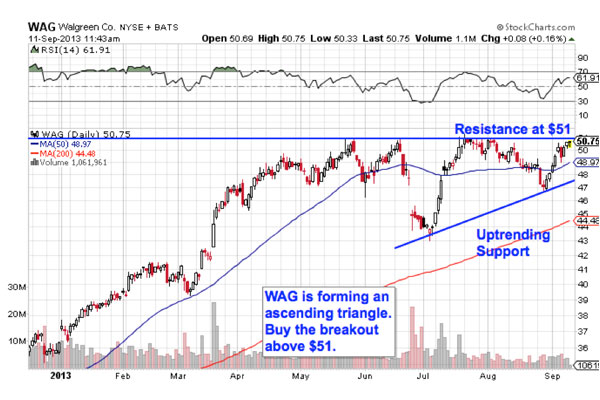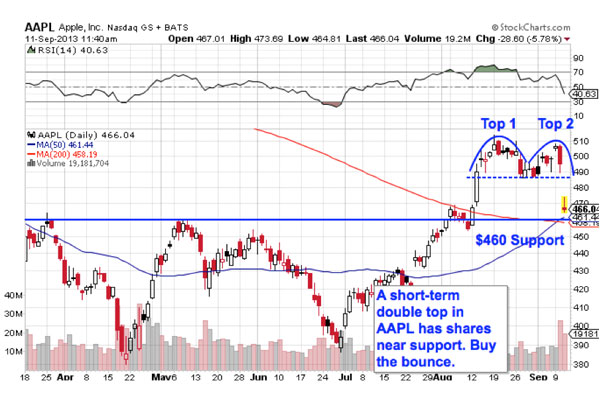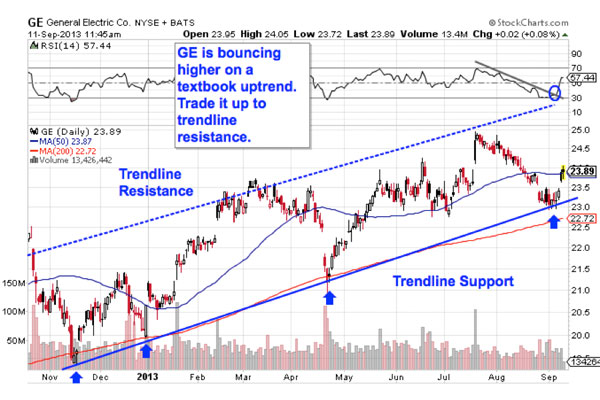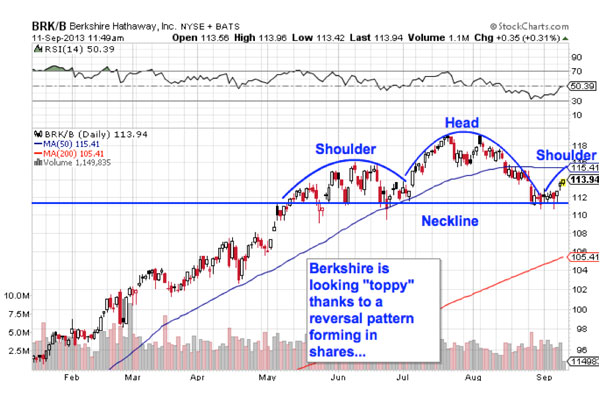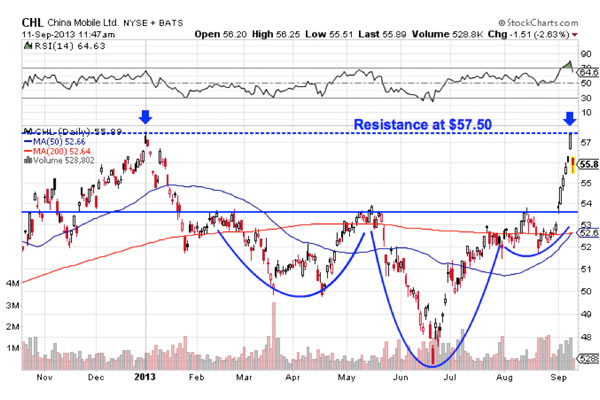With shares of Yum! Brands (NYSE:YUM) trading around $65, is YUM an OUTPERFORM, WAIT AND SEE, or STAY AWAY? Let�� analyze the stock with the relevant sections of our CHEAT SHEET investing framework:
T = Trends for a Stock’s MovementYum Brands is a quick-service restaurant company based on a number of system units, with approximately 37,000 units in more than 120 countries and territories. The company — through its three main restaurant chains KFC, Pizza Hut, and Taco Bell — develops, operates, franchises, and licenses a worldwide system of restaurants. These popular food chains prepare, package, and sell a menu of low-priced food items. Convenient and tasty foods continue to rise in popularity worldwide, which allows Yum Brands to provide food items demanded by consumers worldwide.
Yum Brands shares fell during premarket trading after the owner of fast food joints including KFC and Pizza Hut posted earnings Tuesday that revealed the company is still struggling in China due to an avian flu scare and the slumping Chinese economy. Analysts had expected declines in Yum�� China business, but the company still missed estimates. Yum posted earnings per share of 85 cents, falling below analyst expectations of 93 cents. Same-store sales in China fell 11 percent. “Even with our recent challenges, KFC is unquestionably the category leader in China and we remain confident sales will fully recover from the adverse publicity surrounding the December poultry supply incident,” Yum CEO David Novak said in the company�� earnings report.
Best Low Price Companies To Watch For 2015: Einstein Noah Restaurant Group Inc (BAGL)
Einstein Noah Restaurant Group, Inc. (ENRGI), incorporated on October 21, 1992, is an owner/operator, franchisor and licensor of bagel specialty restaurants in the United States. ENRGI operates under the Einstein Bros. Bagels (Einstein Bros.), Noah�� New York Bagels (Noah��) and Manhattan Bagel Company (Manhattan Bagel) brands. ENRGI operates in three business segments: the Company-owned restaurants segment, the manufacturing and commissary segment, and the franchise and license segment. The Company-owned restaurants segment includes the restaurants that it owns. The manufacturing and commissary segment produces and distributes bagel dough and other products to its Company-owned restaurants, licensees and franchisees and other third parties. The franchise and license segment earns royalties and other fees from the use of trademarks and operating systems developed for the Einstein Bros., Noah�� and Manhattan Bagel brands.
During the fiscal year ended January 1, 2013 (fiscal 2012), ENRGI acquired eight restaurants and opened an additional 15 Company-owned restaurants. It closed one Company-owned restaurant during fiscal 2012. On January 31, 2012, the Company sold a Company-owned restaurant. As of January 1, 2013, it had 816 restaurants in 39 states and in the District of Columbia. In January 2013, the Company opened an Einstein Bros. franchise in Montana. Its product offerings include fresh-baked bagels and other bakery items baked onsite, ma de-to-order breakfast and lunch sandwiches on a range of bagels, breads or wraps, gourmet soups and salads, assorted pastries, premium coffees and an assortment of snacks. Its manufacturing and independent distribution network delivers ingredients that are delivered fresh to its restaurants.
Company-owned restaurants
Einstein Bros. offers a menu that provides food for breakfast and lunch, including fresh-baked bagels and hot breakfast sandwiches, freshly prepared lunch sandwiches, cream cheese and other spreads, specia! lty coffees and teas, soups, salads and other menu offerings. Noah�� is a neighborhood-based bakery/deli restaurant that serves fresh-baked bagels, hot breakfast sandwiches, made-to-order deli-style sandwiches, cream cheese and other spreads, specialty coffees and teas, soups, salads and other menu offerings. Manhattan Bagel provides a traditional New York style boil and baked bagel. Manhattan Bagel also serves a range of grilled sandwiches, freshly made deli sandwiches, freshly prepared breakfast sandwiches, soups, and a range of other fresh-baked sweets. Similar to Einstein Bros. and Noah��, Manhattan Bagel also features a line of fresh brewed coffees and specialty coffee/espresso beverages. During fiscal 2012, ENRGI generated approximately 90% of its total revenue from restaurant sales at its Company-owned restaurants.
Manufacturing and Commissaries
ENRGI operates a bagel dough manufacturing facility in Whittier, California and has contracts with two suppliers to produce bagel dough and sweets to the specifications. These facilities provide frozen dough, partially-baked frozen bagels and fully baked sweets for its Company-owned restaurants, franchisees and licensees. These operations provide the restaurants with food products, such as sliced meats, cheeses, and/or certain salad ingredients. It has recipes and production processes for the bagel dough, cream cheese and coffee. Frozen, or partially baked and frozen, bagel dough is shipped to all of its Company-owned, franchised and licensed restaurants where the dough is then baked onsite. Its purchases other ingredients used in the restaurants, such as meat, lettuce, tomatoes and condiments, from a select group of third party suppliers.
Franchise and Licensing
ENRGI offers Einstein Bros. franchises to qualified area developers. As of January 1, 2013, the Company was registered to offer Einstein Bros. franchises in 49 states and the District of Columbia. It also has a franchise base in the Manhatt! an Bagel ! brand. Its licensees are located primarily in colleges and universities, hospitals, airports and military bases. As of February 25, 2013, it had 28 development agreements in place for 136 total restaurants, 34 of which have already opened. During fiscal 2012, it opened 13 franchised locations and 27 licensed locations. During fiscal 2012, approximately 3% of its total revenue was generated by the Company�� franchise and license operations.
Advisors' Opinion:- [By MARKETWATCH]
SAN FRANCISCO (MarketWatch) -- Wall Street hedge-fund investor David Einhorn was active in the last quarter of 2013, taking new stakes in technology and energy companies, while trimming existing holdings in insurer Aetna (AET) , NCR Corp (NCR) and WPX Energy (WPX) , according to an SEC filing Friday. Einhorn's Greenlight Capital picked up stakes in Anadarko Petroleum (APC) , BP (BP) , McDermott Intl. (MDR) , Micron Technolgy (MU) and Take-Two Interactive (TTWO) , according to the latest 13F filing. He trimmed stakes in Aetna, Einstein Noah (BAGL) and WPX Energy, according to the filing.
- [By John Udovich]
At the end of last week, small cap sandwich stock Potbelly Corp (NASDAQ: PBPB) had a delicious surge of 120% for its IPO���meaning its probably a good idea to see whether its still worth getting in on the action plus take a look at the performance of peers�Cosi Inc (NASDAQ: COSI), Panera Bread Co (NASDAQ: PNRA) and Einstein Noah Restaurant Group, Inc (NASDAQ: BAGL) as Subway remains private. I should mention that competing with Subway in the sandwich business is a tall order as they have 40,229 restaurants in 102 countries and territories as of early September���making them the�largest single-brand restaurant chain and the largest restaurant operator globally. However, Potbelly Corp and its peers Cosi Inc, Panera Bread Co and Einstein Noah Restaurant Group aren�� slugging it out directly with Subway.
Top Restaurant Companies To Own For 2014: El Pollo Loco Holdings Inc (LOCO)
El Pollo Loco Holdings, Inc., formerly EPL Holdings, Inc., incorporated in 1999, own, operate and franchise restaurants specializing in marinated, flame-grilled chicken. During the fiscal year ended December 28, 2005 (fiscal 2005), the Company's restaurant system had 340 restaurants, consisting of 146 company-operated and 194 franchised restaurants, located principally in California, with additional restaurants in Arizona, Nevada, Texas and Illinois. In fiscal 2005, the Company closed one company-operated and one franchised restaurant and it opened six company-operated and seven franchised restaurants. The Company's restaurant is a freestanding building ranging from approximately 2,200 to 2,600 square feet with seating for approximately 60 customers and offering drive-thru convenience.
The Company's menu features flame-grilled chicken and includes approximately 50 items, most of which it prepares from scratch. The Company serves a range of individual and family-size chicken meals, which include flour or corn tortillas, salsas and a range of side orders, such as Spanish rice and pinto beans. In addition, the Company offers a range of Mexican-inspired entrees featuring marinated, flame-grilled chicken as the central ingredient, including its specialty Pollo Bowl, Pollo Salads, signature burritos, chicken quesadillas, chicken tortilla soup and chicken tacos.
Advisors' Opinion:- [By Monica Gerson]
El Pollo Loco Holdings, Inc.(NASDAQ: LOCO) shares gained 3.69% to $21.63 in the pre-market trading session. Jefferies upgraded El Pollo Loco from Hold to Buy and lowered the price target from $30.00 to $27.00.
Top Restaurant Companies To Own For 2014: Richoux Group PLC (RIC)
Richoux Group plc is a United Kingdom-based company engaged in the operation of restaurants. The Company has three segments: Richoux, Villagio Zippers and Dean�� Diner. Richoux restaurants operate in the areas of central London. The restaurants are open all day for breakfast, lunch, afternoon tea and dinner. The restaurants also offers patisserie. Zippers is a spacious, stylish and contemporary restaurant with a relaxed ambience. Dean's Diner offers a range of freshly prepared dishes. Villagio is a modern local Italian restaurant with a menu suitable for the whole family. The Company�� subsidiaries include Newultra Limited and Richoux Limited. Advisors' Opinion:- [By Sally Jones]
Richmont Mines Inc. (RIC)Down 70% over 12 months, Richmont Mines Inc. has a market cap of $56.23 billion, and trades with a P/B of 0.60.
- [By Roberto Pedone]
Richmont Mines (RIC) engages in the mining, exploration and development of mining properties, principally gold in Canada. This stock closed up 2.4% to $1.68 in Tuesday's trading session.
Tuesday's Range: $1.61-$1.68
52-Week Range: $1.31-$5.50
Tuesday's Volume: 76,000
Three-Month Average Volume: 101,786From a technical perspective, RIC bounced higher here right off its 50-day moving average of $1.59 with decent upside volume. This stock has been uptrending strong for the last month and change, with shares moving higher from its low of $1.31 to its recent high of $1.71. During that move, shares of RIC have been making mostly higher lows and higher highs, which is bullish technical price action. That move has now pushed shares of RIC within range of triggering a near-term breakout trade. That trade will hit if RIC manages to take out some near-term overhead resistance at $1.71 to $1.80 with high volume.
Traders should now look for long-biased trades in RIC as long as it's trending above its 50-day at $1.59 or above more near-term support levels at $1.50 to $1.44 and then once it sustains a move or close above those breakout levels with volume that hits near or above 101,786 shares. If that breakout triggers soon, then RIC will set up to re-test or possibly take out its next major overhead resistance levels at $2.10 to $2.20. Any high-volume move above those levels will then give RIC a chance to tag its 200-day moving average at $2.48.
- [By John Udovich]
Small cap�paper stock�Verso Paper Corp (NYSE: VRS), trucking stock�Covenant Transportation Group, Inc (NASDAQ: CVTI) and gold mining stock Richmont Mines Inc (NYSEMKT: RIC) are among the best small cap stock performers for the�year and the best in their respective sectors because they are�up 390.7%, 224.7% and 215%, respectively, since the start of the year. Why has the paper, trucking and gold mining sector produced three top performing small cap stocks? Here are some answers:
Top Restaurant Companies To Own For 2014: Brinker International Inc (EAT)
Brinker International, Inc. (Brinker), incorporated on September 30, 1983, owns, develops, operates and franchises the Chili�� Grill & Bar (Chili��) and Maggiano�� Little Italy (Maggiano��) restaurant brands. As of June 27, 2013 (fiscal 2013), the Company's system of Company-owned and franchised restaurants included 1,591 restaurants located in 50 states, and Washington, D.C. It also has restaurants in the Bahrain, Brazil, Canada, Columbia, Costa Rica, Dominican Republic, Ecuador, Egypt, El Salvador, Germany, Guatemala, Honduras, India, Indonesia, Japan, Jordan, Kuwait, Lebanon, Malaysia, Mexico, Oman, Peru, Philippines, Qatar, Russia, Saudi Arabia, Singapore, South Korea, Syria, Taiwan, United Arab Emirates and Venezuela.
Chili�� Grill & Bar
Chili�� operates in the Bar and Grill category of casual dining. The Company has operations worldwide, with locations in 32 foreign countries and two United States territories. Chili�� menu features items, such as Baby Back Ribs smoked in-house, Big Mouth Burgers, Sizzling Fajitas, hand-battered Chicken Crispers and house-made Chips and Salsa. The all-day menu offers a range of appetizers, entrees and desserts. A special lunch section is available on weekdays. In addition to its flavorful food, Chili�� offers a line of alcoholic beverages available from the bar, including Margaritas and draft beer. During fiscal 2013, food and non-alcoholic beverage sales constituted approximately 86.1% of Chili�� total restaurant revenues, with alcoholic beverage sales accounted for the remaining 13.9%.
Maggiano�� Little Italy
Maggiano�� is a full-service, casual dining Italian restaurant brand. Its Maggiano�� restaurants feature individual and family-style menus, and its restaurants also have banquet facilities designed to host party business or social events. It has lunch and dinner menu offering chef-prepared, classic Italian-American fare in the form of appetizers, entrees with portions of pasta, ch! icken, seafood, veal and prime steaks, and desserts. The Company�� Maggiano�� restaurants also offer a range of alcoholic beverages, including wines. In addition, Maggiano�� offers a full carryout menu, as well as local delivery services. During fiscal 2013, food and non-alcoholic beverage sales constituted approximately 83.0% of Maggiano�� total restaurant revenues, with alcoholic beverage sales accounted for the remaining 17.0%.
Advisors' Opinion:- [By Tom Rojas var popups = dojo.query(".socialByline .popC"); popups.forEach(func]
Brinker International Inc.(EAT) said its first-quarter profit increased 12%, helped by higher sales at its Chili’s Grill & Bar and Maggiano’s Little Italy chains.
- [By Shauna O'Brien]
Shares of restaurant company Brinker International, Inc. (EAT) skyrocketed on Wednesday morning after the company reported higher Q2 earnings that beat analysts’ expectations.�
EAT’s Earnings in Brief�
EAT reported Q2 net income of�$39.74 million, or 58 cents per share, up from $37.18 million, or 50 cents per share, a year ago. Excluding special items, earnings were 43 cents per share, up from 37 cents per share last year. Revenue for the quarter was�$704.39 million, up from $689.76 million in the second quarter of last year. On average, analysts expected to see EPS of 58 cents and revenue of�$699.23 million. Earnings were helped by cost cutting measures at�Chili’s Grill & Bar and Maggiano’s Little Italy restaurants.CEO Commentary
CEO and president of EAT, Wyman Roberts, commented:�”We remain encouraged about the trajectory of our business as results from this past quarter demonstrate our steady progress of driving top-line sales, while increasing value for our shareholders.”
EAT’s Dividend�
The company is expected to declare its next quarterly dividend of 24 cents in February. EAT paid its last quarterly payment on December 26. In August, EAT raised its dividend by 20% from 20 cents to 24 cent per share.
Stock Performance
Brinker International shares were up $4.21, or 9.02%, during pre-market trading Wednesday.
- [By Jake L'Ecuyer]
Equities Trading UP
Brinker International (NYSE: EAT) shot up 6.40 percent to $49.68 as the company reported upbeat FQ2 earnings.Shares of Textron (NYSE: TXT) got a boost, shooting up 7.51 percent to $38.81 after the company reported a 13% rise in its fourth-quarter income.
Top Restaurant Companies To Own For 2014: Country Style Cooking Restaurant Chain Co Ltd (CCSC)
Country Style Cooking Restaurant Chain Co., Ltd. (CSC Cayman), incorporated on August 14, 2007, is a quick service restaurant chain in China. The Company offers delicious, everyday Chinese food. The Company conducts all of its restaurant operations through CSC China and its subsidiaries. As of June 30, 2012, it had 256 restaurants, including 124 restaurants in Chongqing municipality and 85 restaurants in Sichuan province.
Chongqing municipality and Sichuan province cover a region of 110 million people in Southwest China. CSC Cayman directly operates all of its restaurants. Its standard menu features its main dishes prepared in the Sichuan style, as well as a selection of other dishes, appetizers, desserts and beverages. The Company periodically offers new dishes and seasonal menu selections.
The Company competes with McDonald��, KFC and Yoshinoya.
Advisors' Opinion:- [By CRWE]
Country Style Cooking Restaurant Chain Co., Ltd (NYSE:CCSC), a fast-growing quick service restaurant chain in China, plans to release its unaudited second quarter 2012 financial results on Tuesday, August 14, 2012, after the market closes.
Top Restaurant Companies To Own For 2014: Popeyes Louisiana Kitchen Inc (PLKI)
Popeyes Louisiana Kitchen Inc, formerly AFC Enterprises, Inc. incorporated on July 27, 1992, develops, operates, and franchises quick-service restaurants (QSRs or restaurants) under the trade names Popeyes Chicken & Biscuits and Popeyes Louisiana Kitchen (collectively Popeyes). Within Popeyes, it manages two business segments: franchise operations and ompany-operated restaurants. Within the QSR industry, Popeyes distinguishes itself with a Louisiana style menu, which features spicy chicken, chicken sandwiches, chicken tenders, fried shrimp and other seafood, red beans and rice and other regional items. As of December 25, 2012, the Company operated and franchised 2,104 Popeyes restaurants in 47 states, the District of Columbia, Puerto Rico, Guam, the Cayman Islands and 26 foreign countries. As of December 25, 2012, of its 1,634 domestic franchised restaurants, approximately 70% were concentrated in Texas, California, Louisiana, Florida, Illinois, Maryland, New York, Georgia, Virginia and Mississippi. Of its 425 international franchised restaurants, approximately 60% were located in Korea, Canada, and Turkey. Of its 45 Company-operated restaurants, approximately 80% were concentrated in Louisiana and Tennessee. In November 2012, the Company acquired 27 restaurants in Minnesota and California.
As of December 25, 2012, the Company had 340 franchisees operating restaurants within the Popeyes system. During the fiscal year ended December 25, 2012 (fiscal 2012), the Popeyes system opened 141 restaurants, which included 75 domestic and 65 international restaurants. During fiscal 2011, the Popeyes system permanently closed 75 restaurants, resulting in 66 net restaurant openings, compared to 65 net openings. As of December 25, 2012, it leased 12 restaurants and subleased 44 restaurants to franchisees. In addition, it leased three properties to unrelated third parties. Of the restaurants leased or subleased to franchisees, 29 were located in Texas and 16 were located in Georgia. On November 7, 2012,! the Company entered into a new agreement with the King Features Syndicate Division of Hearst Holdings, Inc., licensor of the Popeye the Sailorman and associated cartoon characters.
Advisors' Opinion:- [By Rick Aristotle Munarriz]
Alamy Fried chicken and waffles is a staple menu item at countless soul food and comfort food restaurants, but that's not stopping Burger King (BKW) from trying to give the meal a fast-food spin. Burger King is testing a new sandwich in the Northeast that takes the breaded chicken patty used in its Classic Crispy Chicken Sandwich from its King Deals Value Menu and replaces the bun with a split waffle. Burger King's Chicken & Waffle Sandwich isn't as hearty as the meal that it's based on. It's selling for as little as $2.29. But the chain's latest attempt to turn heads with a unique menu item will at least attract curious nibblers if it does decide to broaden the offering across the country. Waffling About Burger King isn't the first popular chain to attempt to reinvent this classic dish. As Nation's Restaurant News points out, last summer, Popeyes Louisiana Kitchen (PLKI) offered Chicken Waffle Tenders -- consisting of chicken tenders dipped in a vanilla maple-scented waffle batter, served with a honey maple dipping sauce. DineEquity's (DIN) IHOP did it three years ago by combining its chicken strips with Belgian waffle quarters. Yum! Brands (YUM) tried to breathe new life into its breakfast business last summer by testing a Waffle Taco -- an egg, sausage, and waffle breakfast sandwich. Even if it doesn't succeed -- and some of the early taste tests haven't been very flattering to the chain's new sandwich -- it's at least comforting to see that Burger King isn't just copying McDonald's (MCD) the way that it has for the past couple of years. Burger King followed McDonald's in offering fancy coffee drinks, fresh fruit smoothies, and popcorn chicken. It has gone on to roll out doppelgangers of the Egg McMuffin and McRib sandwiches. In November, it introduced the Big King, which any patron will quickly recognize as a body double to the Big Mac. Then again, it's not as if following McDonald's lead is such a clever idea right now. The world's largest re
- [By Steve Symington]
With the taste of last quarter's�solid performance�still fresh on investors' palates, Popeyes Louisiana Kitchen (NASDAQ: PLKI ) just served up another plate of mixed quarterly results. But this time, the quick-service restaurant chain added a little extra kick with its guidance.
- [By Mark Yagalla]
As the fast-food wars heat up, restaurants are getting more creative with their menu items. One item that is getting a lot of attention is the waffle. Two restaurant chains that have introduced their own variations of the waffle are Taco Bell, owned by Yum! Brands (NYSE: YUM ) �and Popeyes Louisiana Kitchen (NASDAQ: PLKI ) . Taco Bell has made the Waffle Taco a centerpiece of its new breakfast menu. Meanwhile, Popeyes is bringing back its popular Chicken Waffle Tenders. Could the waffle be the answer and boost same-store sales for these restaurants? If it is the answer, expect to see more variations of the waffle on many more menu boards.
- [By Sue Chang]
Popeyes Louisiana Kitchen Inc. (PLKI) �is expected to report first-quarter earnings of 45 cents a share.
